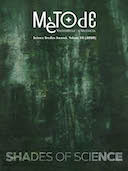Humanos 2.0: Escribiendo el futuro de la evolución humana
DOI:
https://doi.org/10.7203/metode.10.12554Palabras clave:
secuenciación del genoma, edición genética, modificación genética humana, determinismo genético, bioética Resumen
Resumen
¿Podremos los humanos dirigir la evolución futura de nuestra especie? Basándonos en los conocimientos actuales en genética, se puede inferir y extrapolar qué puede pasar en un futuro más próximo. Al fin y al cabo, si hay que predecir el futuro, debemos comprender las bases de nuestro presente. Para responder a la pregunta inicial, presentaré brevemente qué sabemos sobre nuestro genoma y si tenemos suficientes datos para inferir cómo somos (lo que se denomina correlación genotipo-fenotipo), para pasar a presentar los adelantos tecnológicos actuales y su potencial impacto en nuestra evolución.
 Descargas
Descargas
 Citas
Citas
Apte, R. S. (2018). Gene therapy for retinal degeneration. Cell, 173(1), 5. doi: 10.1016/j.cell.2018.03.021
Beans, C. (2018). Science and culture: Wearable tech meets tattoo art in a bid to revolutionize both. Proceedings of the National Academy of Sciences of the USA, 115(14), 3504–3506. doi: 10.1073/pnas.1803214115
De Lecuona, I., Casado, M., Marfany, G., López-Baroni, M., & Escarrabill, M. (2017). Gene editing in humans: Towards a global and inclusive debate for responsible research.
Yale Journal of Biology and Medicine, 90(4), 673–681. PMID: 29259532
Gaskell, G., Bard, I., Allansdottir, A., Vieira da Cunha, R., Eduard, P., Hampel, J., ... Zwart, H. (2017). Public views on gene editing and its uses. Nature Biotechnology, 35, 1021–1023. doi: 10.1038/nbt.3958
Gerbault, P., Liebert, A., Itan, Y., Powell, P., Currat, M., Burger, J. ... Thomas, M. J. (2011). Evolution of lactase persistence: An example of human niche construction. Philosophical Transactions of the Royal Society of London B Biological Sciences, 366(1566), 863–877. doi: 10.1098/rstb.2010.0268
Hirsch, T., Rothoeft, T., Teig, N., Bauer, J. W., Pellegrini, G., De Rosa, L. ... De Luca, M. (2017). Regeneration of the entire human epidermis using transgenic stem cells. Nature, 551, 327–332. doi: 10.1038/nature24487
Kalia, S. S., Adelman, K., Bale, S. J., Chung, W. K., Eng, C., Evans, J. P. ... Miller, D. T. (2017). Recommendations for reporting of secondary findings in clinical exome and genome sequencing, 2016 update (ACMG SF v2.0): A policy statement of the American College of Medical Genetics and Genomics. Genetics in Medicine, 19(2), 249–255. doi: 10.1038/gim.2016.190
Ku, C. S., Polychronakos, C., Tan, E. K., Naidoo, N., Pawitan, Y., Roukos, D. H. ... Cooper D. N. (2013). A new paradigm emerges from the study of de novo mutations in the context of neurodevelopmental disease. Molecular Psychiatry, 18(2), 141–153. doi: 10.1038/mp.2012.58
Lim, E. T., Uddin, M., De Rubeis, S., Chan, Y., Kamumbu, A. S., Xhang, X., ... Walsh, C. A. (2017). Rates, distribution and implications of postzygotic mosaic mutations in autism spectrum disorder. Nature Neuroscience, 20, 1217–1224. doi: 10.1038/nn.4598
McCullough, J. M., Heath, K. M., & Smith, A. M. (2015). Hemochromatosis: Niche construction and the genetic domino effect in the European Neolithic. Human Biology, 87(1), 39–58. PMID: 26416321
Mojica, F. J. M., & Montoliu, L. (2016). On the origin of CRISPR-Cas technology: From prokaryotes to mammals. Trends in Microbiology, 24(10), 811–820. doi: 10.1016/j.tim.2016.06.005
Montoliu, L., Merchant, J., Hirsch, F., Abecassis, M., Jouannet, P., Baertschi, B., ... & Chneiweiss, H. (2018). ARRIGE arrives: Toward the responsible use of genome editing. The CRISPR Journal, 1(2), 128–129. doi: 10.1089/crispr.2018.29013.mil
Roukos, D. H. (2014). Innovation versus evidence: To trust direct-to-consumer personal genomic tests? Expert Review of Molecular Diagnostics, 11, 1–4. doi: 10.1586/erm.10.99
Santander, N. G., Contreras-Duarte, S., Awad, M. F., Lizama, C., Passalacqua, I., Rigotti, A., & Busso, D. (2013). Developmental abnormalities in mouse embryos lacking the HDL receptor SR-BI. Human Molecular Genetics, 22(6), 1086–1096. doi: 10.1093/hmg/dds510
The 1000 Genomes Project Consortium. (2015). A global reference for human genetic variation. Nature, 526, 68–74. doi: 10.1038/nature15393
Vernot, B., & Pääbo, S. (2018). The predecessors within... Cell, 173(1), 6–7. doi: 10.1016/j.cell.2018.03.023
Wang, H., La Russa, M., & Li, Q. S. (2016). CRISPR/Cas9 in genome editing and beyond. Annual Reviews in Biochemistry, 85, 227–264. doi: 10.1146/annurev-biochem-060815-014607
Descargas
Publicado
Cómo citar
-
Resumen6812
-
PDF 826
Número
Sección
Licencia
![]()
Todos los documentos incluidos en OJS son de acceso libre y propiedad de sus autores.
Los autores que publican en esta revista están de acuerdo con los siguientes términos:
- Los autores conservan los derechos de autor y garantizan a Metode Science Studies Journal el derecho a la primera publicación del trabajo, licenciado bajo una licencia de Creative Commons Reconocimiento-NoComercial-SinObraDerivada 4.0 Internacional, que permite a otros compartir el trabajo con un reconocimiento de la autoría del trabajo y citando la publicación inicial en esta revista.
- Se permite y se anima a los autores a difundir sus trabajos electrónicamente a través de páginas personales e institucionales (repositorios institucionales, páginas web personales o perfiles a redes profesionales o académicas) una vez publicado el trabajo.





